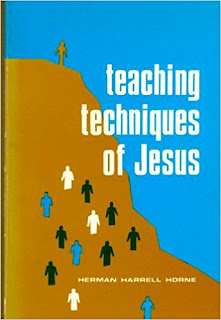Learning How To Teach From Jesus, part 1
They were astonished at his teaching because he was teaching them as one who had authority, and not like the scribes.
...Now what are the elements essentially involved in the teaching situation?
Next time: Chapter 2: AN OBJECT LESSON IN TEACHING, John 4, How Jesus taught the Woman of Samaria.
-Mark 1:22
I have a book by Herman Harrell Horne, called "Teaching Techniques of Jesus", (Jesus The Master Teacher, 1920), that I am going to share my notes from. This is the best book, from the past 100 years, on how Jesus taught. Even though Jesus may have preached sermons, shared teachings, or given homilies; the gospels record Jesus teaching in many different ways, other than lecturing or giving speeches.
I linked to the book, for purchase, above. You can also download the book for free, from archive.org, here.
I linked to the book, for purchase, above. You can also download the book for free, from archive.org, here.
I think that when we read a verse that says "Jesus taught", our minds start at how we teach, preach, or give messages. We imagine that Jesus preached sermons, like we do, whether it was to small groups or huge crowds. But that really is not the case.
We might imagine that Jesus is like us or our favorite pastor, teaching by giving great messages, in front of a group of people; in a lecture, monologue style.
We might imagine that Jesus is like us or our favorite pastor, teaching by giving great messages, in front of a group of people; in a lecture, monologue style.
If you are a teacher, whether your classroom is your dining room table, with your child; or if it is your church building's sanctuary, and you stand behind a pulpit; you might want to learn how to teach like Jesus. I do.
You can follow the link above, for a bio of Horne. This is what Angus M. Gunn wrote about Horne, in the 1998 edition:
"Herbert Harrell Horne was the first educator in modern times to recognize both the value and relevance of Jesus as a teacher and the features of his pedagogy that were superior to those prevailing in the public schools of the United States. This book is an eloquent testimony to Horne's understanding of the former, that is, to Jesus as a teacher, we need to look further afield, into Horne's life and his other publications,if we are going to grasp the extent of his influence over the educational world of the 1920's and 1930's.
"Horne was born in Clayton, NC, on November 22, 1874, a third-generation son of a Scottish immigrant. Following school and university studies in his home state (he earned two degrees from the University of North Carolina by the age of 22), he went on to Harvard to complete his Ph.D. two years later, in 1899. His thesis, "History and Philosophy of the Problem of Sin," set the stage for an illustrious career in teaching and writing on many aspects of education and Christian faith. By 1906 his first two major books, The Philosophy of Education and Psychological Principles of Education, were published by the MacMillan Company of New York. The academic year 1906-1907 was spent in postgraduate study at the University of Berlin....
...In the first edition of this book Horne made it clear that it was not a book to be read so much as a guide to be followed in study classes. It was especially designed for discussion groups. He consistently stressed that his viewpoint was not the content of Jesus' teaching but rather the form in which the content is cast. This was how he described his teaching method: "The mode of presentation will, so far as possible, make the reader a sharer in the process of discovering the methods of Jesus as a teacher. This result will be accomplished first by raising questions, then giving the reader a chance to answer them tentatively for himself or herself, and finally presenting additional material to reach a more considered conclusion."
TEACHING SITUATION
Chapter 1, quotes & notes: (direct quotes are in italics)
We are going to study "how Jesus taught." This implies that he was acquainted with the teaching situation, even that he was a part of it, and faced its problems; that he was confronted by the same kind of difficulties in teaching as we, if not the identical ones....
The teaching situation involves:
- a teacher
- a pupil
- environment
- curriculum
- aim (goal of teacher)
- method (way of teaching)
The scene of Jesus and Nicodemus, in John 3, has all six of these.
- Jesus
- Nick
- Night, for privacy and secrecy
- "Birth from above"
- To affect great change in the pupil
- Q & A, a remarkable illustration, and the element of surprise
Two other examples to think about and look for the teaching situation therein are the story in John 4 of Jesus' encounter with the Samaritan Woman, and the Great Confession, in Matthew 16. Homework: Read all four gospels and look for all the leading teaching situations in the life of Jesus.
Something to think about (for later chapters): Are the miracles Jesus wrought teaching situations? For example, look at Mark 2:1-11 and Luke 5:1-11.
The question is, do Jesus' miracle situations teach us? If not, then what is the purpose of them?
This book will focus mainly on #6, from above in the teaching situation of Jesus: the methods Jesus used as a teacher.

Comments
Post a Comment